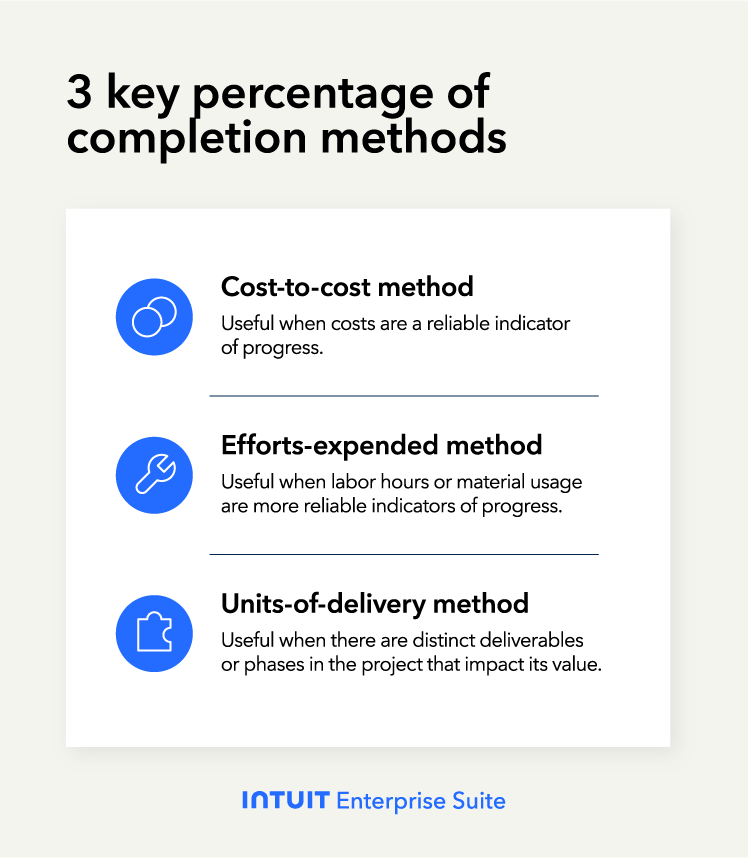Why the percentage method is important
The POC accounting method works on the principle that you should be able to track revenue in line with the project’s progress. It means that if 50% of a project is complete, you should be able to calculate 50% of the total expected revenue. As the project progresses and incurs more production costs, the percentage of completion increases, leading to a corresponding increase in recognized revenue.
Construction businesses can benefit greatly from the percentage of completion accounting method. Here are some of its benefits:
- Accurate revenue recognition: You’ll get a more accurate representation of the company's financial performance. It also helps prevent overstating or understating revenue, which can distort financial statements and mislead stakeholders.
- Improved cash flow management: You can more accurately forecast the company’s income and plan expenses, helping to improve cash flow management and reduce the risk of financial difficulties.
- Enhanced financial reporting: You can get more informative and timely financial reporting (and recognize revenue as it is earned). It will help you present a clearer picture of your company’s financial health to investors, lenders, and other stakeholders.
- Adherence to GAAP: Long-term contracts, particularly in the construction industry, typically require the POC method because it helps businesses adhere to Generally Accepted Accounting Principles (GAAP). It aligns revenue recognition with project progress, providing a more accurate financial picture.
In essence, the POC method tracks progress in real time, which can produce even deeper insights when paired with a custom ERP system.
Enterprise resource planning (ERP) solutions make it easier to predict and avoid cost overruns by streamlining resource management, cash flows prediction, and project risks assessment. Its integrated reporting capabilities provide analytics that can also highlight trends, helping you make data-driven decisions to keep projects profitable and efficient.
The percentage of completion method adjustment
Initial estimates for costs and progress are often subject to change. The percentage of completion method adjustment addresses this by requiring companies to revise revenue recognition calculations when project costs or progress estimates are updated.
When project variables change, these adjustments help you:
- Improve cash flow management: Your budgeting becomes more precise, allowing for better resource allocation and cost control.
- Enhance budgeting accuracy: You make more informed decisions about cash flow, preventing surprises and enabling proactive financial planning.
- Boost stakeholder confidence: You'll foster trust with investors, lenders, and other stakeholders, as they receive an accurate representation of project performance.
- Mitigate risks effectively: You can identify potential issues, such as cost overruns or delays before they escalate.
As your project progresses and evolves, so should your projections.
Percentage of completion vs. completed contract method
The POC method recognizes revenue and associated expenses as work progresses, providing a continuous, real-time view of your financial health. So, if your project is 50% complete, you're only recognizing 50% of the expected revenue and costs.
In contrast, the completed contract method (CCM) defers the recognition of both revenue and expenses until the project is completed. While simpler, this method can obscure a company's financial performance during long-term projects, potentially leading to less accurate interim financial statements.
Choosing POC means aligning your financial reporting with actual project progress, offering a clearer picture of profitability and cash flow at every stage.






 Producing the right POC method calculations is essential for accurate financial reporting. Ensure your accountants have reliable cost estimates and maintain open communication with project managers to assess project complexity.
Producing the right POC method calculations is essential for accurate financial reporting. Ensure your accountants have reliable cost estimates and maintain open communication with project managers to assess project complexity.

 A tax professional can help you ensure compliance with IRS guidelines when using the percentage of completion method. Tax laws can be complex and may vary based on the project and business structure.
A tax professional can help you ensure compliance with IRS guidelines when using the percentage of completion method. Tax laws can be complex and may vary based on the project and business structure.




